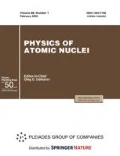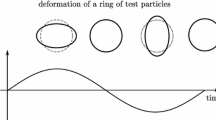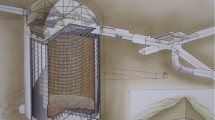Abstract
The IceTop detector is the surface component of the IceCube Observatory: an array of 81 ‘‘stations’’ of two frozen water tanks. Each tank contains two photosensors, and is sensitive to both the electromagnetic component of cosmic ray air showers as well as surface muons. While the electromagnetic component dominates in tanks close to the shower core, the signals from muons become more pronounced at large distances and at high zenith angles. Additionally, the deeply-buried in-ice component of IceCube can measure the high-energy penetrating muons from air showers. Together, these detectors can study the distributions of these air shower muons, and by comparing to the predictions of various hadronic interaction models, use them to constrain these models.




Similar content being viewed by others
REFERENCES
A. Achterberg et al. (IceCube Collab.), Astropart. Phys. 26 155 (2006).
R. Abbasi et al. (IceCube Collab.), Nucl. Instrum. Methods A 700, 188 (2013).
M. G. Aartsen et al. (IceCube Collab.), Phys. Rev. D 100, 082002 (2019).
M. G. Aartsen et al. (IceCube Collab.), Astropart.Phys. 78, 1 (2016).
T. Fuchs et al. (IceCube Collab.), in Proceedings of the 25th ECRS, Turin, 2016 (2017); arXiv:1701.04067 [astro-ph.HE].
H. Dembinski et al. (EAS-MSU, IceCube, KASCADE-Grande, NEVOD-DECOR, Pierre Auger, SUGAR, Telescope Array, and Yakutsk Collabs.), in Proceedings of UHECR, 2018 (2019); arXiv:1902.08124 [astro-ph.HE].
J. Gonzalez et al. (IceCube Collab.), in Proceedings of ISVHECRI, Japan, 2018, EPJ Web Conf. 208, 03003 (2019).
T. K. Gaisser, Astropart. Phys. 35, 801 (2012).
D. Heck, J. Knapp, J. N. Capdeviell, G. Schatz, and T. Thouw, CORSIKA: A Monte Carlo Code to Simulate Extensive Air Showers, FZKA 6019 (Forschungszentrum Karlsruhe, 1998).
S. Agostinelli et al. (Geant4 Collab.), Nucl. Instrum. Methods A 506, 250 (2003).
E. J. Ahn, R. Engel, T. K. Gaisser, P. Lipari, and T. Stanev, Phys. Rev. D 80, 094003 (2009).
F. Riehn, R. Engel, A. Fedynitch, T. K. Gaisser, and T. Stanev, EPJ Web Conf. 99, 12001 (2015).
S. Ostapchenko, Nucl. Phys. B Proc. Suppl 151, 143 (2006).
T. Pierog et al., Phys. Rev. C 92, 034906 (2015).
D. Soldin et al. (IceCube Collab.), in Proceedings of ISVHECRI, 2018, EPJ Web Conf. 208, 08007 (2019); arXiv:1811.03651 [astro-ph.HE].
R. Enberg, M. Reno, and I. Sarcevic, Phys. Rev. D 78 043005 (2008).
S. deRidder et al. (IceCube Collab.), in Proceedings of the 35th ICRC, 2017 (2017); PoS(ICRC2017)319.
Author information
Authors and Affiliations
Corresponding author
Additional information
(for the IceCube Collaboration)
Rights and permissions
About this article
Cite this article
Rawlins, K. Measurements of Cosmic Ray Muon Distributions with IceTop and IceCube. Phys. Atom. Nuclei 83, 285–289 (2020). https://doi.org/10.1134/S1063778820020246
Received:
Revised:
Accepted:
Published:
Issue Date:
DOI: https://doi.org/10.1134/S1063778820020246




